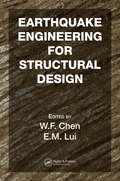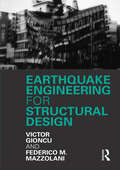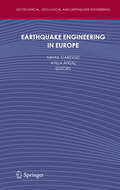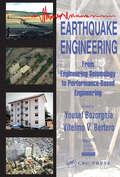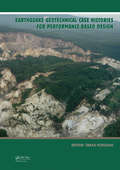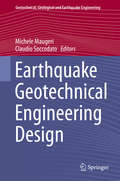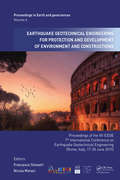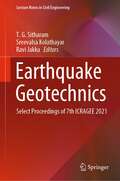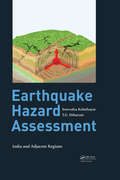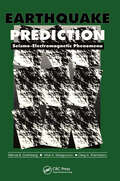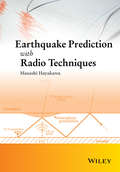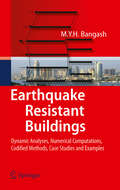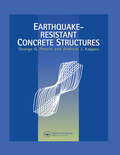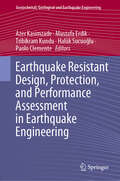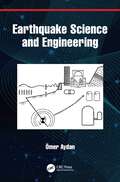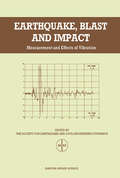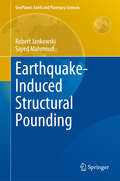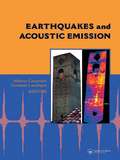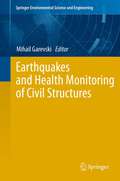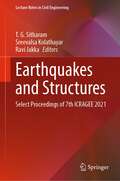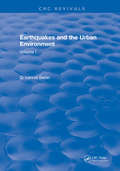- Table View
- List View
Earthquake Engineering for Structural Design
by W. F. Chen E. M. LuiMany important advances in designing earthquake-resistant structures have occurred over the last several years. Civil engineers need an authoritative source of information that reflects the issues that are unique to the field. Comprising chapters selected from the second edition of the best-selling Handbook of Structural Engineering, this book provides a tightly focused, economical guide to the theoretical, practical, and computational aspects of earthquake engineering. It discusses the fundamentals of earthquake engineering, the various types of earthquake damage to structures, seismic design of buildings and bridges, and performance-based seismic design and evaluation of building structures.
Earthquake Engineering for Structural Design
by Victor Gioncu Federico MazzolaniDevelopments in Earthquake Engineering have focussed on the capacity and response of structures. They often overlook the importance of seismological knowledge to earthquake-proofing of design. It is not enough only to understand the anatomy of the structure, you must also appreciate the nature of the likely earthquake.Seismic design, as detailed in
Earthquake Engineering in Europe
by Atilla Ansal Mihail GarevskiThis book contains 9 invited keynote and 12 theme lectures presented at the 14th European Conference on Earthquake Engineering (14ECEE) held in Ohrid, Republic of Macedonia, from August 30 to September 3, 2010. The conference was organized by the Macedonian Association for Earthquake Engineering (MAEE), under the auspices of European Association for Earthquake Engineering (EAEE). The book is organized in twenty one state-of-the-art papers written by carefully selected very eminent researchers mainly from Europe but also from USA and Japan. The contributions provide a very comprehensive collection of topics on earthquake engineering, as well as interdisciplinary subjects such as engineering seismology and seismic risk assessment and management. Engineering seismology, geotechnical earthquake engineering, seismic performance of buildings, earthquake resistant engineering structures, new techniques and technologies and managing risk in seismic regions are all among the different topics covered in this book. The book also includes the First Ambraseys Distinguished Award Lecture given by Prof. Theo P. Tassios in the honor of Prof. Nicholas N. Ambraseys. The aim is to present the current state of knowledge and engineering practice, addressing recent and ongoing developments while also projecting innovative ideas for future research and development. It is not always possible to have so many selected manuscripts within the broad spectrum of earthquake engineering thus the book is unique in one sense and may serve as a good reference book for researchers in this field. Audience: This book will be of interest to civil engineers in the fields of geotechnical and structural earthquake engineering; scientists and researchers in the fields of seismology, geology and geophysics. Not only scientists, engineers and students, but also those interested in earthquake hazard assessment and mitigation will find in this book the most recent advances.
Earthquake Engineering: From Engineering Seismology to Performance-Based Engineering
by Yousef Bozorgnia Vitelmo V. BerteroThis multi-contributor book provides comprehensive coverage of earthquake engineering problems, an overview of traditional methods, and the scientific background on recent developments. It discusses computer methods on structural analysis and provides access to the recent design methodologies and serves as a reference for both professionals and res
Earthquake Geotechnical Case Histories for Performance-Based Design: ISSMGE TC4 2005-2009 Term Volume
by Takaji KokushoEarthquake Geotechnical Case Histories for Performance-Based Design is a collection of 26 case histories, each study containing well-instrumented geotechnical and earthquake data. The book is intended to serve as a reference work, since it contains a common scale to develop and implement design methodologies and numerical analyses, so that their re
Earthquake Geotechnical Engineering Design
by Michele Maugeri Claudio SoccodatoPseudo-static analysis is still the most-used method to assess the stability of geotechnical systems that are exposed to earthquake forces. However, this method does not provide any information about the deformations and permanent displacements induced by seismic activity. Moreover, it is questionable to use this approach when geotechnical systems are affected by frequent and rare seismic events. Incidentally, the peak ground acceleration has increased from 0. 2-0. 3 g in the seventies to the current value of 0. 6-0. 8 g. Therefore, a shift from the pseudo-static approach to performance-based analysis is needed. Over the past five years considerable progress has been made in Earthquake Geotechnical Engineering Design (EGED). The most recent advances are presented in this book in 6 parts. The evaluation of the site amplification is covered in Part I of the book. In Part II the evaluation of the soil foundation stability against natural slope failure and liquefaction is treated. In the following 3 Parts of the book the EGED for different geotechnical systems is presented as follows: the design of levees and dams including natural slopes in Part III; the design of foundations and soil structure interaction analysis in Part IV; underground structures in Part V. Finally in Part VI, new topics like the design of reinforced earth retaining walls and landfills are covered.
Earthquake Geotechnical Engineering for Protection and Development of Environment and Constructions: Proceedings of the 7th International Conference on Earthquake Geotechnical Engineering, (ICEGE 2019), June 17-20, 2019, Rome, Italy (Proceedings in Earth and Geosciences)
by Francesco Silvestri, Nicola MoraciEarthquake Geotechnical Engineering for Protection and Development of Environment and Constructions contains invited, keynote and theme lectures and regular papers presented at the 7th International Conference on Earthquake Geotechnical Engineering (Rome, Italy, 17-20 June 2019. The contributions deal with recent developments and advancements as well as case histories, field monitoring, experimental characterization, physical and analytical modelling, and applications related to the variety of environmental phenomena induced by earthquakes in soils and their effects on engineered systems interacting with them. The book is divided in the sections below: Invited papers Keynote papers Theme lectures Special Session on Large Scale Testing Special Session on Liquefact Projects Special Session on Lessons learned from recent earthquakes Special Session on the Central Italy earthquake Regular papers Earthquake Geotechnical Engineering for Protection and Development of Environment and Constructions provides a significant up-to-date collection of recent experiences and developments, and aims at engineers, geologists and seismologists, consultants, public and private contractors, local national and international authorities, and to all those involved in research and practice related to Earthquake Geotechnical Engineering.
Earthquake Geotechnics: Select Proceedings of 7th ICRAGEE 2021 (Lecture Notes in Civil Engineering #187)
by T. G. Sitharam Sreevalsa Kolathayar Ravi JakkaThis volume presents select papers presented at the 7th International Conference on Recent Advances in Geotechnical Earthquake Engineering and Soil Dynamics. The papers discuss advances in the fields of soil dynamics and geotechnical earthquake engineering. Some of the themes include ground response analysis & local site effect, seismic slope stability & landslides, application of AI in geotechnical earthquake engineering, etc. A strong emphasis is placed on connecting academic research and field practice, with many examples, case studies, best practices, and discussions on performance based design. This volume will be of interest to researchers and practicing engineers alike.
Earthquake Hazard Assessment: India and Adjacent Regions
by Sreevalsa Kolathayar T.G. SitharamThis book represents a significant contribution to the area of earthquake data processing and to the development of region-specific magnitude correlations to create an up-to-date homogeneous earthquake catalogue that is uniform in magnitude scale. The book discusses seismicity analysis and estimation of seismicity parameters of a region at both finer and broader levels using different methodologies. The delineation and characterization of regional seismic source zones which requires reasonable observation and engineering judgement is another subject covered. Considering the complex seismotectonic composition of a region, use of numerous methodologies (DSHA and PSHA) in analyzing the seismic hazard using appropriate instruments such as the logic tree will be elaborated to explicitly account for epistemic uncertainties considering alternative models (for Source model, Mmax estimation and Ground motion prediction equations) to estimate the PGA value at bedrock level. Further, VS30 characterization based on the topographic gradient, to facilitate the development of surface level PGA maps using appropriate amplification factors, is discussed. Evaluation of probabilistic liquefaction potential is also explained in the book. Necessary backgrounds and contexts of the aforementioned topics are elaborated through a case study specific to India which features spatiotemporally varied and complex tectonics. The methodology and outcomes presented in this book will be beneficial to practising engineers and researchers working in the fields of seismology and geotechnical engineering in particular and to society in general.
Earthquake Prediction
by Mikhail B. GokhbergThis study presents an account of electromagnetic phenomena in the earth's crust immediately preceding a tectonic earthquake. The results of experiments performed throughout the last 20 years using data collected from the satellite and ground-based observations are analyzed and form the basis of various conceptual explanations of seismo-electromagnetic phenomena. The authors also present their own theoretical model of the generation of electromagnetic emission in the earth's crust. The tendency for earthquake-prone areas to be used for modern urban and industrial development underlines the significance of this monograph. Its applications are extensive, including defrectoscopy, monitoring stress in mines, and the development of electromagnetic methods of earthquake prediction; and should interest geologists, geophysicists, and specialists in solid-state physics.
Earthquake Prediction
by Saumitra MukherjeeThis publication on earthquake prediction provides the fascinating research findings of earthquake prediction by studying space weather environment of the earth. The influence of changes in Sun is shown on the thermosphere, ionosphere, atmosphere and on lithosphere before the earthquakes.
Earthquake Prediction with Radio Techniques
by Masashi HayakawaThe latest achievements of earthquake prediction via radio communication systems, by the world's leading authority Prof. Hayakawa is one of the world leaders in the field of seismo-electromagnetics for EQ prediction and this area of research is still evolving Presents the fundamentals of radio communications and radio propagation, using the radio noises and propagation anomalies as a precursor of earthquakes Considers the combination of different kinds of seismogenic electromagnetic signals of both natural and artificial character Timely topic following the recent sequence of highly destructive earthquakes around the world
Earthquake Resistant Buildings
by M.Y.H. BangashThis concise work provides a general introduction to the design of buildings which must be resistant to the effect of earthquakes. A major part of this design involves the building structure which has a primary role in preventing serious damage or structural collapse. Much of the material presented in this book examines building structures. Due to the recent discovery of vertical components, it examines not only the resistance to lateral forces but also analyses the disastrous influence of vertical components. The work is written for Practicing Civil, Structural, and Mechanical Engineers, Seismologists and Geoscientists. It serves as a knowledge source for graduate students and their instructors.
Earthquake Resistant Concrete Structures
by Andreas KapposThis book introduces practising engineers and post-graduate students to modern approaches to seismic design, with a particular focus on reinforced concrete structures, earthquake resistant design of new buildings and assessment, repair and strengthening of existing buildings.
Earthquake Resistant Design, Protection, and Performance Assessment in Earthquake Engineering (Geotechnical, Geological and Earthquake Engineering #54)
by Tribikram Kundu Halûk Sucuoğlu Mustafa Erdik Azer Kasimzade Paolo ClementeThis book covers the latest advances in the popular research areas in Earthquake Engineering: Seismic Protection, Non-Destructive Testing and Structural Health Monitoring, as well as Seismic Performance Assessment. Part I includes seven chapters on seismic protection systems, a new passive isolation system for tower structures, frictional base isolation systems, period changeable isolation systems and presented applications, and recent developments in Italy, Japan and Macedonia. Also, particularities of design basis ground motion for long period structures are explained. Soil-Structure interaction models on the relevant subject are presented by classifying them. Part II presents three chapters on the new developments on Non-Destructive Testing (NDT) and Structural Health Monitoring (SHM) for Performance Assessment of Structures. Applications and recent developments in USA, Canada, and Turkey are presented. Part III includes eight chapters on Seismic Performance Assessment. The subject of this part is presented on its following important components, and results are discussed: New criterion on performance based seismic design with application to a high-rise building; seismic design and performance assessment of a super tall concrete core wall building; seismic design and evaluation of high-performance modular tall timber building; challenges to detailed finite element analysis of entire building structures; seismic performance evaluation of traditional Japanese wooden houses with outer-frame reinforcement; dynamic response of pipeline, subjected to subsurface and surface blast explosion; bond behavior of sand-coated CFRP rebar embedded in concrete are given; seismic resistant large-span shell structures are presented. The book presents a concise summary of latest research findings, and will be of interest to a wide range of professionals in earthquake engineering, including graduate students, instructors, designers, and researches.
Earthquake Science and Engineering
by Ömer AydanEarthquakes form one of the categories of natural disasters that sometimes result in huge loss of human life as well as destruction of (infra)structures, as experienced during recent great earthquakes. This book addresses scientific and engineering aspects of earthquakes, which are generally taught and published separately. This book intends to fill the gap between these two fields associated with earthquakes and help seismologists and earthquake engineers better communicate with and understand each other. This will foster the development of new techniques for dealing with various aspects of earthquakes and earthquake-associated issues, to safeguard the security and welfare of societies worldwide. Because this work covers both scientific and engineering aspects in a unified way, it offers a complete overview of earthquakes, their mechanics, their effects on (infra)structures and secondary associated events. As such, this book is aimed at engineering professionals with an earth sciences background (geology, seismology, geophysics) or those with an engineering background (civil, architecture, mining, geological engineering) or with both, and it can also serve as a reference work for academics and (under)graduate students.
Earthquake Time Bombs
by Robert YeatsIn a media interview in January 2010, scientist Robert Yeats sounded the alarm on Port-au-Prince, Haiti, as an 'earthquake time bomb', a region at critical risk of major seismic activity. One week later, a catastrophic earthquake struck the city, leaving over 100,000 dead and triggering a humanitarian crisis. In this timely study, Yeats sheds new light on other earthquake hotspots around the world and the communities at risk. He examines these seismic threats in the context of recent cultural history, including economic development, national politics and international conflicts. Descriptions of emerging seismic resilience plans from some cities provide a more hopeful picture. Essential reading for policy-makers, infrastructure and emergency planners, scientists, students and anyone living in the shadow of an earthquake, this book raises the alarm so that we can protect our vulnerable cities before it's too late.
Earthquake, Blast and Impact: Measurement and effects of vibration
by Seced - The Society For Earthquake & Civil Engineering DynamicsThis volume consists of papers presented at the International Conference on Earthquake, Blast and Impact held at the University of Manchester Institute of Science and Technology, UK, 18-20 September 1991, organised by the Society for Earthquake and Civil Engineering Dynamics (SECED) and supported by the Institution of Civil Engineers, the Instituti
Earthquake-Induced Structural Pounding
by Robert Jankowski Sayed MahmoudThis books analyzes different approaches to modeling earthquake-induced structural pounding and shows the results of the studies on collisions between buildings and between bridge segments during ground motions. Aspects related to the mitigation of pounding effects as well as the design of structures prone to pounding are also discussed. Earthquake-induced structural pounding between insufficiently separated buildings, and between bridge segments, has been repeatedly observed during ground motions. The reports after earthquakes indicate that it may result in limited local damage in the case of moderate seismic events, or in considerable destruction or even the collapse of colliding structures during severe ground motions. Pounding in buildings is usually caused by the differences in dynamic properties between structures, which make them vibrate out-of-phase under seismic excitation. In contrast, in the case of longer bridge structures, it is more often the seismic wave propagation effect that induces collisions between superstructure segments during earthquakes.
Earthquakes and Acoustic Emission: Selected Papers from the 11th International Conference on Fracture, Turin, Italy, March 20-25, 2005
by Alberto Carpinteri Giuseppe LacidognaEarthquakes are caused by the sudden release of energy during the fracture of stressed rock within the Earth‘s crust. This phenomenon is similar to that which occurs in materials under load, and although they take place on very different scales, these two phenomena - earthquakes in geophysics and damage in structural materials - have similarities.
Earthquakes and Health Monitoring of Civil Structures
by Mihail GarevskiHealth monitoring of civil structures (HMS) is a new discipline, which contributes to successful and on time detection of damages to structures. This book is a collection of chapters on different topics written by leading scientists in the field. It is primarily focused on the latest achievements in monitoring the earthquake effect upon the health of civil structures. The first chapter of the book deals with the geotechnical and structural aspects of the 2010-2011 Christchurch earthquakes. Further chapters are dedicated to the latest HMS techniques of identification of damage to structures caused by earthquakes. Real time damage detection as well as sensors and acquisition systems used for that purpose are presented. The attention is focused on automated modal analysis, dynamic artificial neural networks and wavelet techniques used in HMS. Particular emphasis is put on wireless sensors and piezo-impendance transducers used for evaluation of seismically induced structural damage. The discussion is followed by presentation of case studies of application of health monitoring for buildings and other civil structures, including a super tall structure. The book ends with a presentation of shaking table tests on physical models for the purpose of monitoring their behaviour under earthquake excitation. Audience The book is primarily intended for engineers and scientists working in the field of application of the HMS technique in earthquake engineering. Considering that real time health monitoring of structures represents a sophisticated approach applying the latest techniques of monitoring of structures, many experts from other industries will also find this book useful.
Earthquakes and Structures: Select Proceedings of 7th ICRAGEE 2021 (Lecture Notes in Civil Engineering #188)
by T. G. Sitharam Sreevalsa Kolathayar Ravi JakkaThis volume presents select papers presented at the 7th International Conference on Recent Advances in Geotechnical Earthquake Engineering and Soil Dynamics. The papers discuss advances in the fields of earthquake engineering connected with structures. Some of the themes include soil structure interaction, dynamic analysis, underground structures, vibration isolation, seismic response of buildings etc. A strong emphasis is placed on connecting academic research and field practice, with many examples, case studies, and best practices. This volume will be of interest to researchers and practicing engineers alike.
Earthquakes and the Urban Environment: Volume 1
by G. Lennis BerlinThis monograph attempts to amalgamate recent research input comprising the vivifying components or urban seismology at a level useful to those having an interest in the earthquake and its effects upon an urban environment. However, because some of those interested in the earthquake- urban problem may not have a strong background in the physical sciences.
Earthquakes and the Urban Environment: Volume 2
by G. Lennis BerlinThis monograph attempts to amalgamate recent research input comprising the vivifying components or urban seismology at a level useful to those having an interest in the earthquake and its effects upon an urban environment. However, because some of those interested in the earthquake- urban problem may not have a strong background in the physical sciences.
Earthquakes and the Urban Environment: Volume 3
by G. Lennis BerlinThis monograph attempts to amalgamate recent research input comprising the vivifying components or urban seismology at a level useful to those having an interest in the earthquake and its effects upon an urban environment. However, because some of those interested in the earthquake- urban problem may not have a strong background in the physical sciences.
